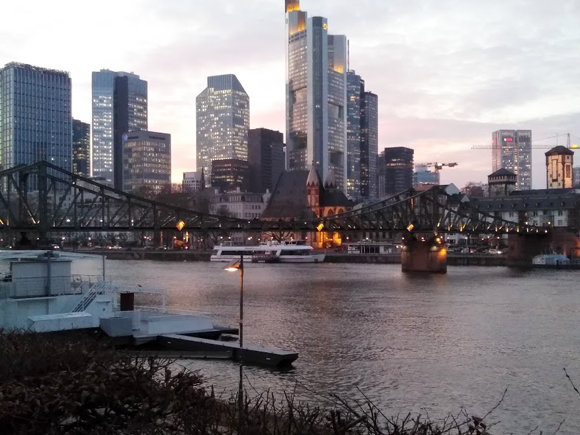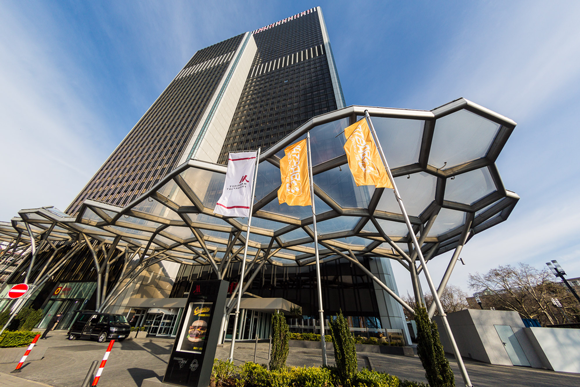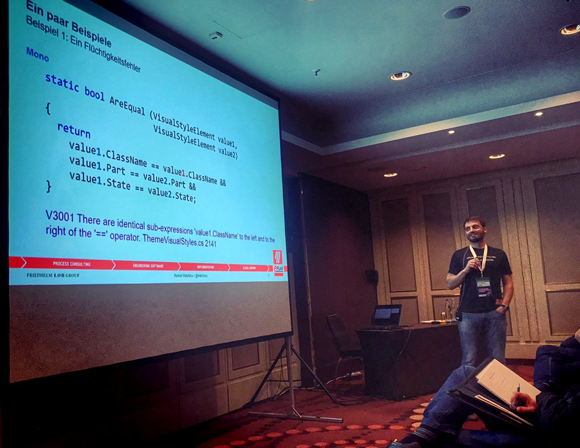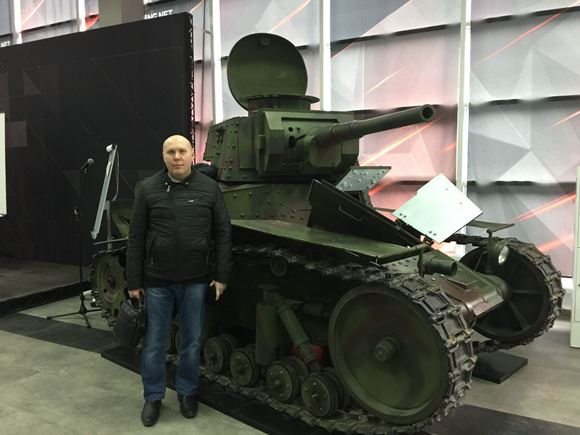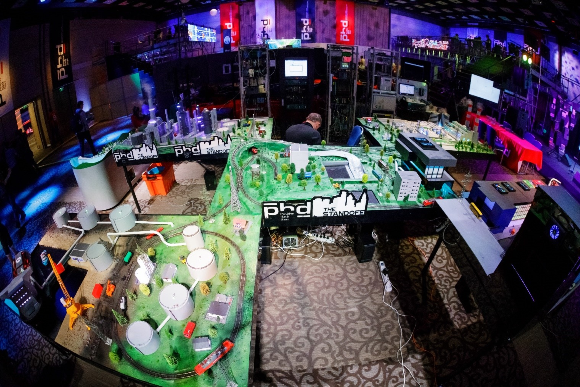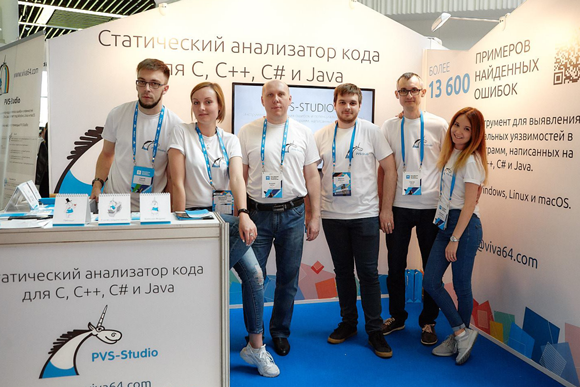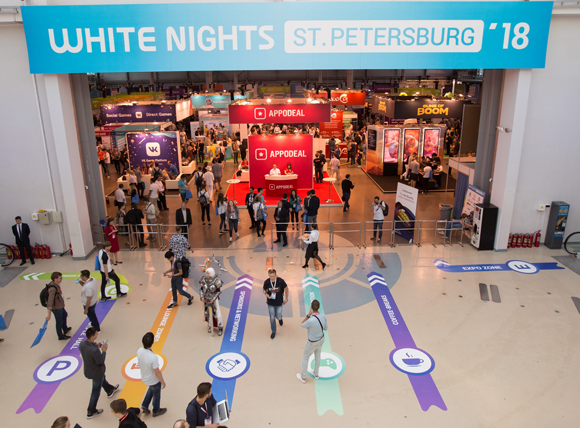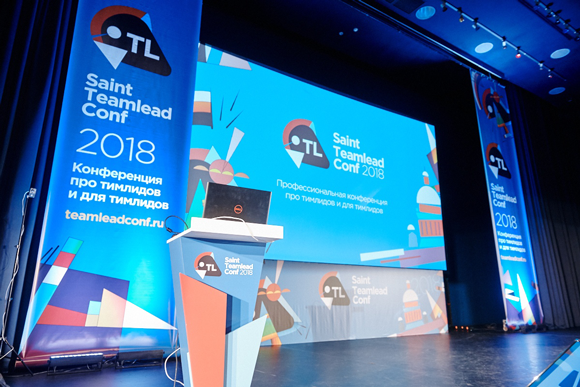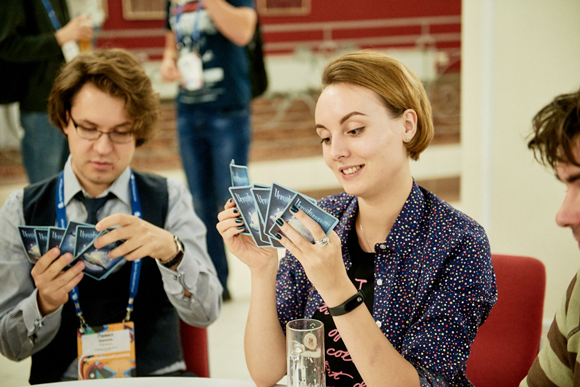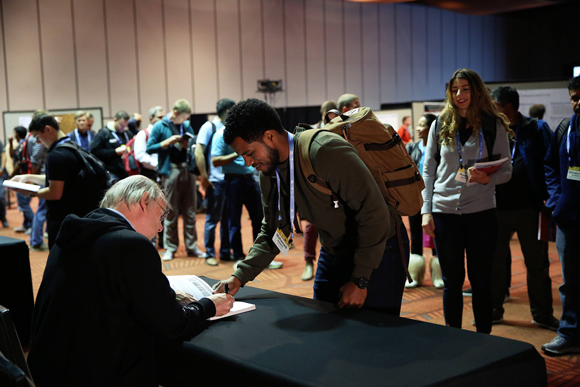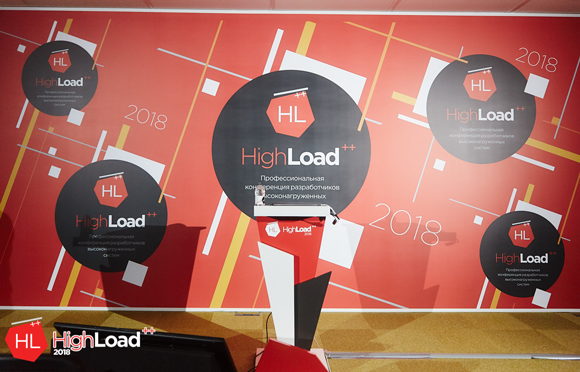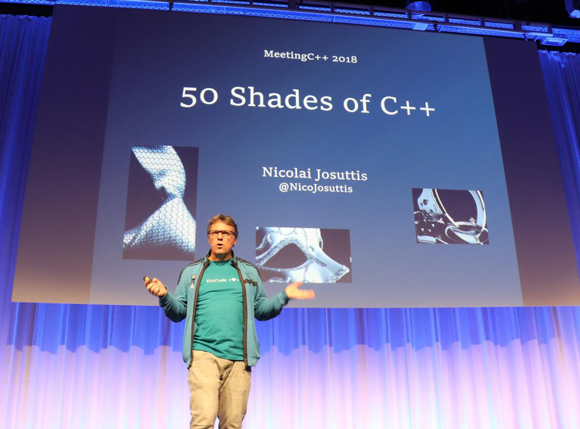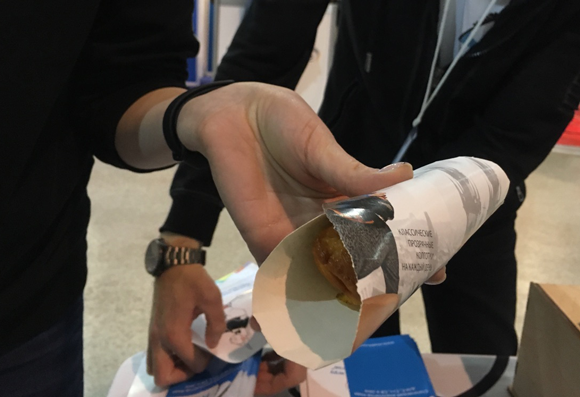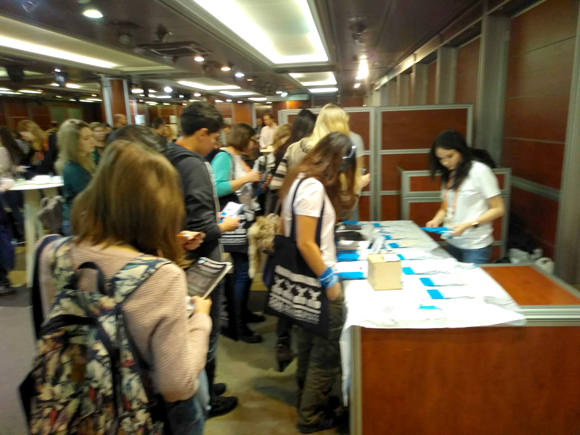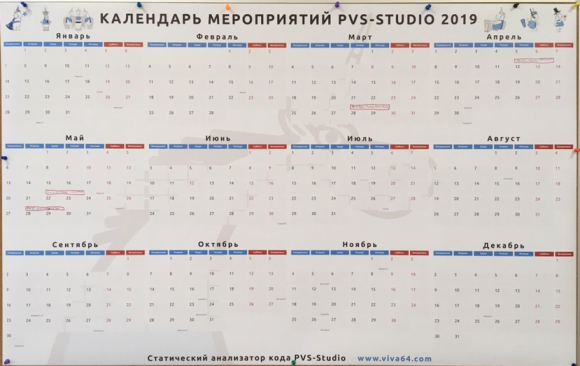Conference time! Summing up the year 2018
Guys! Conferences an hour!
Waiting for a long time foreign lands of us.
There PVS-Studio is he a unicorn,
And the fellow developers,
Answer the question, go to us!
No, we have not smoked, this is just an introduction to this article, where we will tell about our first experience of such a close participation in the 2018 conferences.
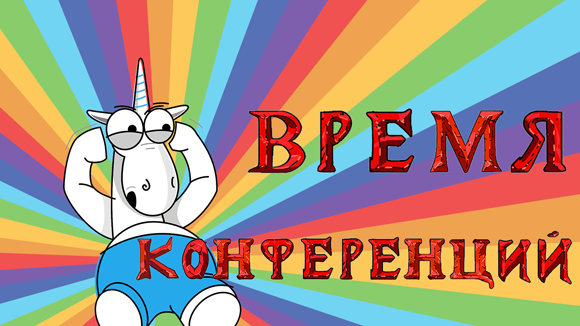
I had such a face when my colleague Andrei Karpov showed me the list of conferences for this year and asked where I would like to go.
From April to mid-December, we regularly attended IT conferences in various cities and countries. In total, this year there were about 23 of them, which is a record for us so far. On some of them we gave presentations, mitaps and master classes, others stood with a stand or were present as listeners, and on the third we did all of the above. Of course, we have taken part in events of various levels before, but not as actively as now. Basically, a couple of times a year, our developers came with reports, but didn’t stand with a stand and didn’t attract people.
')
For clarity and more convenient management of our upcoming trips, Andrew asked to make a half-wall calendar, where he could mark the name of the conferences and the dates of their holding. As you can see from the calendar, nothing is clear, but a lot of things are highlighted, which means that a lot of work was waiting for us.
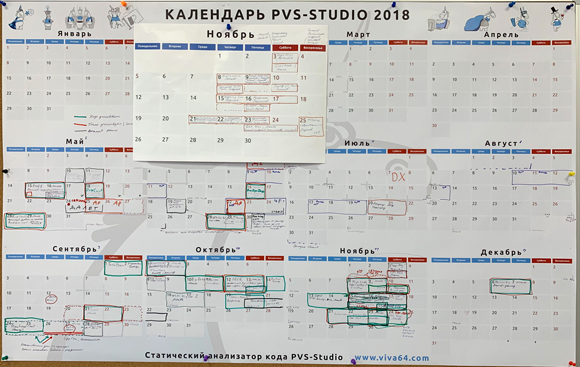
Before listing the conferences themselves, I want to give some advice to those who are just starting to participate in them and tell you in the course of how this is done with us. I will say right away that the tips are more related to grocery companies, which, in part, solve the problems of sales and marketing, rather than those who attend conferences for the sake of hunting. If you are already an experienced stand attendant or a developer who is interested only in reports and is too lazy to read the tips, in your opinion, cap, you can safely move on to the “Conferences in which we participated” section.
Obviously, the stand and what is on it should have some kind of distinctive feature and catch the attention of the participants at a glance so that there is interest to come and talk. But one thing is to say it, and the other is to put it into practice. In fact, the stand is your business card, only on a larger scale. The more creative and informative the business card, compared to the others from the same field, the greater the chance that it will be used.
The company name, logo and main activity should be easy to read and not be too small so that people do not have to break their eyes and peer into the text. And, please, do not write vague words, a la: “We keep up with the times” and “We are cool”, even if this is your company's slogan. No one reads these phrases and for many they are just a faded spot that is ubiquitous in the vast flow of information.
Write keywords that are relevant to the conference theme and will be able to catch the audience you need. For example, at a conference for DevOps developers, you can write the name of well-known platforms where your product can be integrated, on TeamLead - something that will help control the quality of the development process and save the company's budget. For programmer conferences, insert a code that 90% of programmers will notice.
If you have well-known large customers and their logo can be used in advertising, then feel free to add it to the stand, thus, it will attract the attention of the participant. Even if he sees and hears about you for the first time, the probability of being hooked on the familiar icon is greater, which means that an interest and trust relationship may arise.
Important points of the text should not be placed too low - usually not less than 1.5 meters from the floor, so the stand attendant will not close it completely, and everything you have in mind can be noticed by the participants.
You probably think that at first I wrote that the text should be a little bit, but if everything is folded up, then you will get a sheet of letters and pictures. So, under the stand, I understand several components, namely: the back of the Pop Up or Press Wall, stand or table, Roll Up and TV for displaying information or conducting an interactive. How to place everything on these components is up to you.
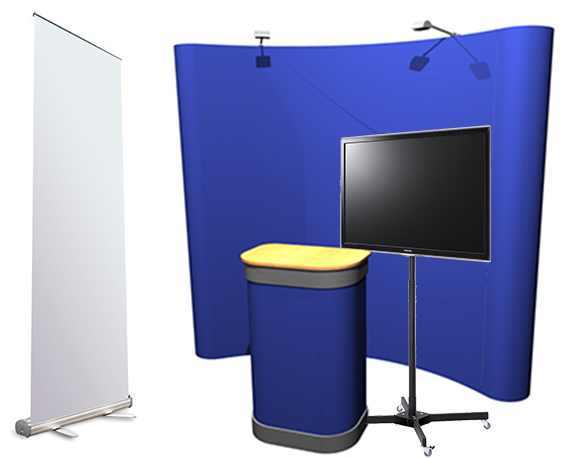
On the image from left to right: white Roll Up, blue Pop Up and stand, where it folds, and the TV (thanks, cap)
We initially did not plan grandiose developments and fashionable modern stands, which are mainly at exhibitions. Because:
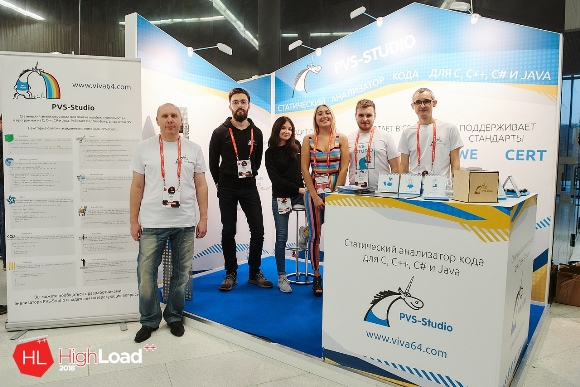
An example of our booth. From left to right: Roll Up, Andrey, Sergey, Ekaterina, Anastasia, Philip, Sergey
And we didn’t lose it, because the stand is an important, but not the main part of the work at the conference.
As we were convinced that no matter how cool and beautiful the stand was, if the people working on it, the handout or the interactive part is lame, then it is immediately useless time and money spent on sponsorship.
It is up to you to give a talk or just be present with a stand, but we think that the most optimal thing is to do both. There are different types of participants: some come only to listen to the reports, and others, on the contrary, to see who is among the sponsors, and to communicate. Therefore, in order to cover all, it is necessary to choose different types of interaction.
Usually the organizers make a brochure where all the reports and the time of their holding are collected. But in a large number of streams and information, people will just skip your talk and go to someone else. Therefore, it would not be superfluous to make flyers, leave them a little on the tables in the dining area, if possible, or attach information boards, and, of course, distribute to everyone who came to your stand.
Regarding the handout - here the flight of fancy is not limited, but we follow the rule that for a mass audience you need to take something more or less compact and light, and also not very expensive to produce.
For example, must-have at any conference are stickers. 99% of participants love and collect them. For the rest, handouts should be tested, finalized, based on the type of conference and audience, and brought back.
So, among the trinkets, magnets, stickers and other things, the most important weapon in the fight for the attention of the participants, we have the status on the desktop for programmers. They are lightweight, compact and reflect all the joy and pain of developers. Then we prepared two more types of such statuses for timlids and for testers.

For rewarding for performing more complex tasks or for the competition, we already choose prizes more expensive and weightier. It is clear that at every conference there are participants who come for a freebie, and they don’t care what to take, the main thing is that it’s free. They are not interested in what you will tell and explain there. “Just give the loot and roll away from me,” - this is his thought at the moment, and why he took it, he will figure it out later. With such, alas, nothing can be done. If recognized immediately, give something that is currently most, and the rest just for the activity.
Activities are a very important part of the job. Without them, you will be able to gather participants only at the beginning of the day, when reports have not yet begun, and many go to the stands just to take some time and see what they give out at the stands. If you are not a very well-known company, and from the handout you only have brochures about who you are and what you do, then people are unlikely to linger for a long time near your booth. In addition, at conferences, no one likes to read information about the company, where "there are many letters." You should always think of some ways to interact with the participants. For example, come up with several tasks that could be interesting to your target audience. It can be like puzzles on the sheet, in the social. networks or online, and playing on a laptop connected to a TV. For completing assignments or passing the game - give prizes, and the harder it was, the better the prize should be. The spirit of competition has not been canceled. In addition, you can then start a conversation and explain what the decision was, or how this task relates to your company.
For example, at the conference in 2018, we carried leaflets with code from various well-known projects that we already tested using the PVS-Studio analyzer. The participant was required to find an uncomplicated but interesting error in this code, and tell its essence. Whether they succeeded or not - for us this is not really important, because, in any case, this aroused interest, and the developers, alone or with colleagues, read the code and tried to identify it. After that, they approached us and showed their decision, and we did not just explain whether it was right or not, but also showed in lines how our analyzer was able to identify it. In the end, for trying, regardless of whether it was successful or not, we gave statuses to the desktop. In this way:
During these 5 steps, the stand attendant positively disposes the participant to himself and to the product, which is thus preparing the ground for further work with him.
We have seen many times how large, widely popular and not very well-known companies are present at conferences with a booth, but they are not taking those people to work on it. The person simply sits in the phone / laptop and is busy with his business, showing with his whole appearance that he is not interested in being here. Or is it an introvert developer who can answer narrow technical questions, but is unable to attract participants and bring them to the conversation.
The man on the stand must be fresh and tidy. In order not to get lost in the motley crowd of participants, make T-shirts or sweatshirts with a logo in your color scheme for each member of your team. Work will have to be active, but the main thing is not to overdo it. Worse indifference can only be the imposition of communication to all participants, which can further alienate. So, ideally, everything happens like this:
The girls, smiling sweetly and greeting each other, attract those who have somehow paid attention to the stand and are already about to go. They bring interested people to the primary conversation about static analysis and PVS-Studio, offer handouts for completing tasks or just like that. Usually, then it becomes interesting for a person to learn some technical details about how the program works, and then our guys are programmers. Of course, we also have developers - hoo, and they can cope with everything themselves without the support of the girls, but this is how we got, and a couple of teams were formed that showed good performance. And the majority of programmers, so most of the time, that at work, that at conferences, they see other similar programmers, so diluting with the female sex, who is interested in their work, would not be superfluous. The main thing is to try to take people not just for beauty, but who are in the subject line, what your company is doing, and can independently tell the general part.
If the conference lasts for several days, networking is best done at the end of the first day, when the organizers have beer parties and invite companies with board and interactive games. In an informal setting, you can easily meet new people and establish business connections, and learn valuable insights.
Also, some organizers arrange meetings for sponsors and some participants the day before the conference, where you can talk with your colleagues at the stands and learn a little more about the companies with which you will soon have to share the attention of the audience.
Networking is undoubtedly a useful thing, about which many articles have already been written in more detail. Therefore, be sure to stock up on a good mood, positive attitude, business cards, and try to enjoy what is happening.
In addition to the list of conference titles, with a short description of each conference, where we spoke, there will be a video and a presentation with a download link, if possible. Since the video organizers are not laid out immediately, the list will be periodically updated. I hope that in the coming months I will complete it. So, let's begin:
For over 20 years, Basta! - a leading and independent conference on Microsoft technologies and JavaScript. Basta! enables developers associated with C #, .NET-Framework and web technologies to keep abreast of the latest developments.
Basta! Conference for the PVS-Studio team. - This is the first conference outside of Russia and Belarus, which we attended. General Director Yevgeny Ryzhkov represented us, and this was the first “appearance” in the role of participant, speaker and sponsor.
View of the city of Frankfurt am Main
Here is how Eugene commented on this event:
Of course, only positive impressions remained from the city of Frankfurt am Main, but even more impressions were from the event itself. For the first time, I ended up at a conference of programmers, where to the question: “What do you know about PVS-Studio?” People answered: “PVS-Studio? And what is it? And it is beautiful! For us, this is a new audience, a new market, new people who still do not know about our product. Although, frankly, this is surprising, since, perhaps, Germany is in second place after the United States in the number of PVS-Studio sales in the world. This estimate is not accurate data, but I think I was not very wrong.
Marriott Hotel, where the conference was held
We sponsored the conference, and we also made a report. More precisely, we asked one of our German clients, EPLAN Software, to make a presentation on static code analysis. Roman told about it, in particular, about the experience of using PVS-Studio in their company. The report was in German, so I did not understand a word.
To be honest, I, of course, completely failed at work at a booth in the conference hall. I had neither a handout, nor colleagues who know how to work at conferences, as I was convinced later in Russia, nor any knowledge of the language. But since Basta! - this is a new audience, I am sure that we will come back here. And we will be prepared as it should!
CoreHard is a conference for C ++ developers, uniting not only C ++, but also those who are interested in C, assembler, industrial controllers and high-loaded server solutions.
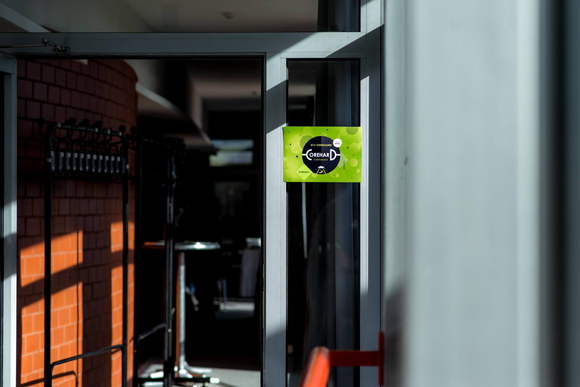
This conference is the full opening of our season 2018. For three years, we come to Minsk every year as sponsors and we can say that each time the conference raises the bar and goes to a higher level, both in organization and quality of reports.
For the first time we came to it with a whole delegation of eight people with a booth and a report “How Data Flow Analysis Works in a Static Code Analyzer,” which was beautifully presented by Pavel Belikov.
Here we tested our statuses with a unicorn for programmers and the rest of the razdatku, which successfully entered the participants, understood how it is necessary and not necessary to lure programmers how to communicate with interested people so that they become even more interested and bring introverts to the conversation.
Andrei additionally visited Wargaming office on a friendly visit, where he talked with the team using PVS-Studio. He answered various questions, promised to make some improvements in the analyzer and so on. And, of course, I was photographed at the tank in their office, as without it.
Andrew and the tank
In order not to write a text wrapper, since there are 21 more O_O conferences waiting for us, you can familiarize yourself with the results of a visit to CoreHard from our post in VK .
In the fall, we again visited CoreHard with a new report from Evgeny Ryzhkov “Information Security and Software Development”. The report went well, but at the stand we understood one obvious thing: we need to bring a new handout to the very same conference. We hoped that maybe 70-80% of the new audience will be, and our merch will work as well as the first time. But as it turned out, most of the participants already had it at home, and they wanted to see something new.
Presentations of reports can be downloaded by contacting the official telegram channel of the conference.
C ++ Russia gathers hundreds of experienced developers of the C ++ language, and this is the conference we attend every year, where we already feel at home and could not miss. C ++ was the first to be added to PVS-Studio, and according to it, we developed thousands of diagnostics and checked hundreds of projects .
Despite a certain number of familiar faces among the participants, we still try to convey the idea of the importance of using static analysis tools in projects to improve the quality of the code. The conference is continuously evolving and invites all new gurus and C ++ stars as speakers: Jon Kalb, Daveed Vandevoorde, Andrei Alexandrescu, Herb Sutter and others.
The conference venue at the Park Inn Pribaltiyskaya hotel, where we actually lived, was very convenient. Therefore, we did not have to spend time and effort on the road and transportation of handouts. It was enough to go down a few floors, and now we are on the stand. Based on the previous CoreHard conference and the counting of what was taken, we assumed that what Russia brought to C ++ should be enough for approximately 80% of the participants. And how we made a mistake ... All of the merch work was dismantled in almost half a day, although we tried not to distribute it just like that, but only for completing the tasks. Conclusion: take it with a reserve, it is better then to bring the part back or give it to the participants / stand assistants, but do not sit with a bare stand on the second day (but here, too, it is necessary to take into account the subject of the conference). Here we had as many as 2 reports: from technical director Andrei Karpov, who gathered such a full house that some listeners did not have enough space and had to stand, and lead developer Sergey Vasilyev.
Positive Hack Days is an international forum on practical security.
Sergei Vasiliev was present at the forum, who, as one of the experts at the round table, discussed issues of static analysis and SAST (Static Application Security Testing). Section participants spoke about the problems of safe development and bringing to the developer the idea of the importance of using static analysis.
From the forum itself, I remember the show “Confrontation” in the main hall, in which teams of intruders, defenders and security centers are fighting in a virtual city. For almost 30 hours, these teams fought for control of the city.
Layout of the playing ground
For example, hackers had to hack into urban infrastructure applications in order to disable the railway or turn off the lights. The defenders, in turn, had to either prevent or repair the damage.
In parallel, there were many reports on information security, master classes, and behind the scenes there were exhibitions of the achievements of the information security industry, paintings and art objects, performances of music groups, and entertainment games.
DevConf is an annual professional conference dedicated to leading programming and web development technologies.
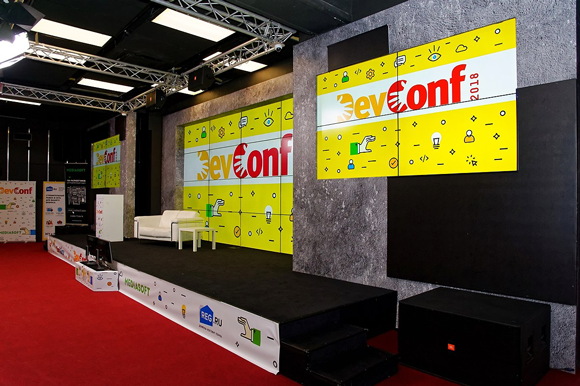
Despite the fact that the main part of the audience was close to the field of programming, there were not many points of contact for us in communication with the participants, as most of them carry out Backend and Mobile development in PHP, Python, JS, Go and others. Probably next time we should come here after a while, when we will support these languages.
Andrei made a presentation “Static code analysis”, where he spoke about his methodology and tools with which the analysis is performed. Videos will be available on the official YouTube channel .
Oleg Bunin's conferences are among the best in Russia in terms of scale, organization, conduct, types and topics of reports. We were convinced of this by visiting RIT ++ for the first time. Unlike other organizers who offer only a certain place in the exhibition hall, and then everything depends on you, how you arrange it, here you will be asked to send mock-ups for the stand and brochures that will greatly simplify your life.
Firstly, if you have a limited budget and you cannot afford to build your own, then you will have a beautiful stand with a cabinet and a TV, which the organizers take upon themselves, and all you have to do is think out the design.
Secondly, it is not necessary to bring with you Pop Up or Press Wall, which, compared to what the organizers offer, will look cheaper and unpresentable.
Thirdly, the majority of such stands go in blocks, do not hurt the eyes and delight perfectionists.
Fourth, brochures additionally help to attract people to your product or stand, depending on how creatively you make them.
From left to right: Sergey, Vasilisa, Andrei, Philip, Sergey and Catherine
RIT ++ gathered people who are interested in system administration and operation, high-loaded systems and databases, server programming, project management and entrepreneurship, as well as front-end development. We found our audience here, were very pleased with the conference and wrote in more detail about it in the article of our VK group. We also suggest that you familiarize yourself with the presentation of the report by Sergey Vasiliev “Static analysis as an answer to the question of improving the quality of the code”
DevOpsDays Moscow conference is devoted to the discussion of current techniques and technologies in the field of software development and maintenance processes.
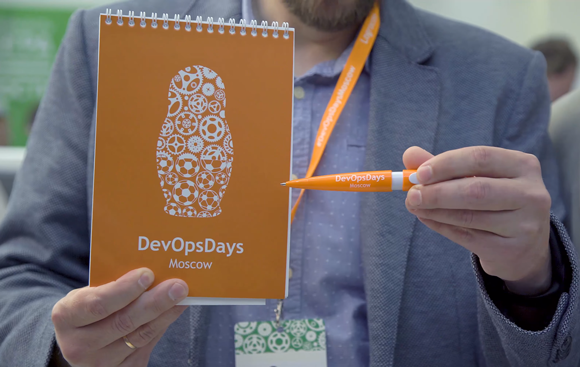
The conference itself is cool, but from the point of view of our communication with visitors at the stand, there were mixed feelings. On the one hand, many participants were “by” and we did not find a point of contact with them. Although, on the other hand, there were visitors who knew about our product and specially approached with various questions about its work and use. We had a long and detailed discussion with some of them. It can be concluded that if the strength and resources remain, the next time it is worth taking part in this conference again.
In addition to the stand here, our developers Phillip and Svyatoslav showed a SonarQube master class for the first time, with which, changing it depending on the conference, they spent the remaining six months. It would seem, and here SonarQube, because we are developing a static analyzer PVS-Studio. But not so simple. SonarQube is a platform for ensuring continuous quality control of the code, which is able to visualize reports by several metrics at once. Such a metric can be analysis results from tools for finding errors and vulnerabilities, such as, for example, PVS-Studio or another static analyzer. So, companies that use several code quality control programs can simplify their lives using SonarQube.
You can watch a video of a similar master class further in the list in the conference Yappi Days.
White Nights Conference is an international business conference dedicated to the development and promotion of games on all platforms (mobile, PC, consoles, web).
Here we stood only with a stand, and here we had a big advantage in the handouts that we took with us. For some reason, people sluggishly disassembled him, and at the end of the second day, in order not to take most of him home, I had to walk around the rest of the stands and give it to other conference participants. Probably, the main part in this was played by the fact that a mixed audience was present at the conference, which included not only programmers, but also designers, marketers, producers and other people who are not only writing code, but developing games in the general sense of the word.
The main difference between gaming conferences and focused directly on developers is the presence of a large number of beautiful and creative stands. Around everything is full of and sparkles from the monitors with prototypes of games, robots, cosplayers and other movement. There were companies side by side - monsters of the Russian gaming industry, and small indie developers. I think the participants were delighted with this event, but for us as sponsors - this is a little past.
IT business conference, which will be useful both for the owner, founders and top of IT companies, and for those who are just going to create a product or open a business in this area.
At ISDEF, many reports were presented on how to organize a business, participate in exhibitions, present a product, bring it to foreign markets, etc. A friendly atmosphere was present here, and networking was held in the evening, which is no less important than standing with a stand or making a presentation.

Of the small minuses in the organization, we would like to note that the time for a report was not always clearly controlled. Because of this, the speeches were increasingly shifted forward and, accordingly, the later the report, the less time left for the next speaker.
In the spring, our company was represented by Evgeny Ryzhkov with the report “10 years on the Developer Tools market: how we changed the product, marketing, and the whole business”, and in the autumn both creators of PVS-Studio, Evgeny Ryzhkov and Andrei Karpov, visited it and told about their experience in conferences with a booth. Unfortunately, the conference organizers do not allow uploading videos and presentations, so there will be no additional links in this section.
Conference for those who want to move to a new level of control for small teams. The second conference from Ontiko (Oleg Bunin), which we attended. We were already familiar with the way everything worked out here, so some things were no longer new to us, but we understood the very key words on the stand for different types of audiences. After all, before that we were only at events where the overwhelming majority are programmers.
Also more clearly shaped their goals of attending conferences. Namely, that now we are not only standing with a stand, we offer to solve problems and tell about our product, but we collect contacts of all those who are interested in PVS-Studio and send them a full Enterprise license for a month.
At this conference, apart from us, there were only 2 sponsors, which allowed the participants not to wander from the booth to the booth, and we were more productive to discuss with them various issues relating to our product. The evening program consisted of a beer party and board games, which allowed the participants to relax after a busy day, as well as make new acquaintances.
A global conference that gathers all C ++ cream. More than 1200 C ++ programmers come here from all over America and beyond. It is here that all the new features related to the C ++ language are presented: standards, versions of popular products, reports of top speakers and authors of books.
Autograph session by Bjorn Straustrup. These are the queues lining up to get an autograph of the great and mighty C ++ author.
Unfortunately, despite the fact that this conference is on this list, none of the members of our team attended it. This is due to the difficulties and unforeseen circumstances, from which it is impossible to be 100% insured. Therefore, we were represented by our friend Robin, who is part of the C ++ community and actively participates in his life. Robin was not there all days, specifically on September 26 and 27, answering questions and telling participants about PVS-Studio.
We hope that next year we will be able to visit CppCon as part of PVS-Studio and convey to the audience about the static analysis methodology and our tool.
Professional conference on the integration of development processes, testing and operation. And again Ontiko, and again we are here. By the way, here we visited the pre-party for sponsors for the first time before the conference.
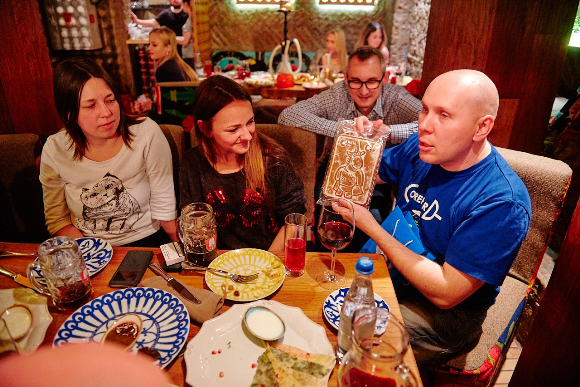
There is no point in repeating how everything is well organized and interesting here, so I’ll just leave a link to Andrei Karpov’s report “SAST, fighting potential vulnerabilities”.
Download the presentation of the report
Conference on Big Data, Data Science & AI. The conference itself was well organized and brought together experienced speakers, but for us it turned out to be not quite thematic and one of the few that we visited this year, where very few people heard about us. At the stand, an interesting dialogue with the participants happened, but not as much as we would like. Apparently, we are not quite suitable for this conference, and it is for us.
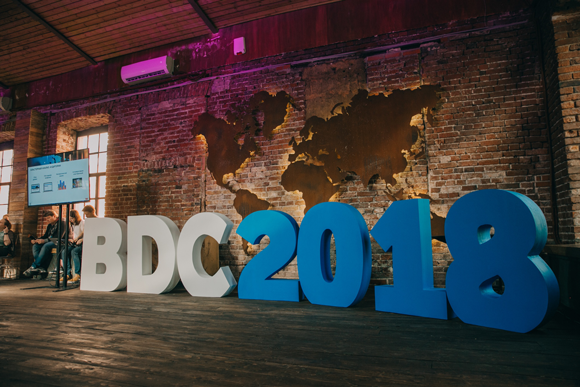
It’s good that we had a premonition that the audience was not entirely ours, and we were able to accurately guess the amount of handouts, taking only a couple of boxes with us. And yes, without Pop Up the wall, the stand looked very simple.

Andrei and Philip, judging by their faces, are very happy that they are being photographed
SECR is one of the most important IT events in Russia with a long history and recognized authority. Conference for programmers, testers and analysts, project and product managers, key decision-makers of the company, the best students and researchers.
Here, our C # developer Sergey Khrenov made his debut as a speaker, where he gave a presentation on “Static code analysis: from typos to vulnerabilities”. The audience warmly received the report and asked interesting questions. In addition, we also tried out the Master Class “The Practice of Using Static Code Analyzers”, which took second place in the rating at this conference. Svyatoslav and Philip talked about various tools in which you can conveniently visualize the results of the analysis and receive reports on many metrics.
The participant who won our hat with earflaps fit so well into the rainbow theme of the unicorn.
We liked how this conference was held. In addition to the performances, we gathered quite a lot of contacts of those who are interested in PVS-Studio, held a prize draw for the first time and are thinking of returning here next year.
https://vimeo.com/298790374
The largest Java conference in Russia, which is growing every year, is becoming more interesting, hardcore and gathers more than 1,000 participants annually.

As a listener, one of our Java developers visited it and was delighted with its conduct, organization, speakers and types of reports. Especially pleased with the audience were Java puzzlers — code snippets, which sometimes work not quite as it seems at first glance. Puzzle players take place in an interactive format (speakers show a section of code and response options of what happens during its execution - the task of the audience to vote) and are an excellent way out if you want to take a break from technical conference hardcore.
Next year we will definitely visit this conference with a booth, and maybe with a report. After all, now PVS-Studio supports searching for errors in the Java language, and we have something to say about this.
Yappi Days - a conference where topics such as: design patterns, corporate systems architecture, distributed systems are raised; cloud technologies, containers, orchestration, Continuous Delivery / Integration; popular front end and backend frameworks; performance and application monitoring.
The last time we had a report in Yaroslavl was 8 years ago. This was the ADD2010 conference. We do not know whether it can be said that ADD2010 is the progenitor of Yappi Days, but, in any case, it is nice to see the development of similar events in Yaroslavl.
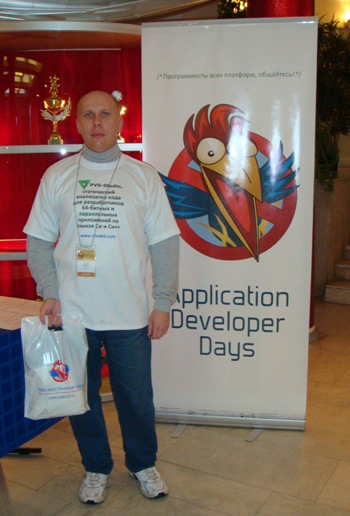
Andrew on ADD2010 The
reports were held on different topics, a sort of RHS ++, only in a smaller format. Compared to previous years, there were more sponsors and stands, so the participants had a diverse choice of communication among the stands. There may have been minor flaws during the lunch organization, but we hope the organizers will fix them in the future, and the conference will be even better. For the rest, we liked Yappi Days and maybe next year we will visit it again. In addition to the booth, we had a report: “Experience in developing a static code analyzer”, as well as a master class: “SonarQube: from installation to analyzing a production code”.
It was very nice when your stand was appreciated by the participants themselves. And although we are in second place, we definitely have where to strive and grow.
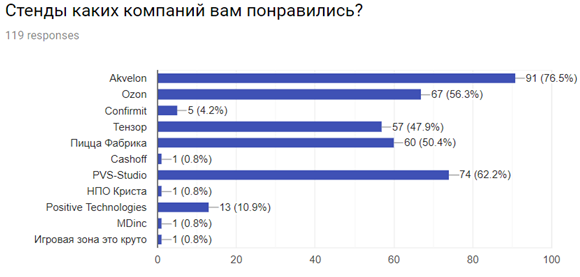
Since the event lasted one day, we decided to spend some more time in Yaroslavl, take a walk around the city and explore its sights. Of course, the Volga, no doubt - the queen of the rivers, which covers dozens of regions of Russia. In this overcast time of the year, we probably could not have been impressed by all its beauty, but passing along the embankment, we felt all the power and strength of this beautiful river. Yaroslavl itself turned out to be small: for a couple of hours, we went around the whole center of the city, where many ancient churches and temples are collected.
In conclusion, I would like to tell you about the wonderful restaurant “Miles”, which put a positive bullet on our trip to Yaroslavl. There are very few places like this place in Moscow, what can we say about the other cities of Russia. The interior, the kitchen, the service, the prices, the serving and the appearance of the dishes - all this exceeded our expectations. Given that we were limited in time and hurried to the train, we were served exactly minute by minute of strictly allotted time. Of course, it may be that we arrived, when the restaurant was just opening and there wasn’t much people, but we think that even if they have a full landing, you will still be served at the highest level. Anyone who goes to Yaroslavl, we recommend to go there.
This is not an advertisement, we just really enjoyed it there, and many positive reviews about this restaurant testify to this.
Finally, a video of the report and the master class:
Highload ++ is the largest professional conference for developers of high-load systems from Ontiko. This is the largest and coolest conference this year, where we were. 3000 participants walked in a tight stream both days and did not let them relax for a minute. It was good for us. We tried to devote time to everyone (although it was not easy) and to diversify our presence on the stand with various activities and competitions. More about our participation is written in the VC group .
Video reports will be publicly available only in April.
The largest regional conference for IT-business and professionals, which is organized by local companies. Since the region is far from Moscow / Peter (fly four hours, only not to +30 to Egypt, but to -20 to Tomsk), then people want to have some kind of movement. Here they also do them. “IT City” is a very broad conference, and this is its minus for us, but in itself it is, of course, very interesting.
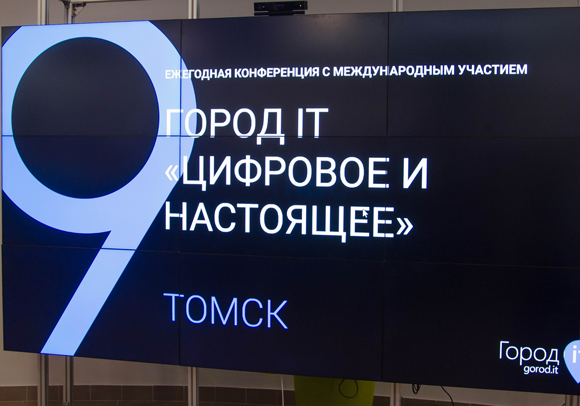
This year there was a section on C ++, which was organized by the company TomskSoft. Anton Tushmintsev from this company invited Yevgeny Ryzhkov to make a presentation on “Patterns of C ++ errors that manifest themselves in cross-platform development”. Of course, he knew that the history of PVS-Studio began with the product Viva64, which was developed just to find problems when migrating to 64-bit systems. In addition, PVS-Studio now runs on Windows, Linux and macOS. Therefore, we can tell you something about the development of cross-platform applications.
Further, according to Eugene:
“I was the first time in Tomsk. I flew there from +5, and flew in at -20. It is invigorating! And flew off at five in the morning, standing on the runway of the airfield at -25 degrees. Despite this, it was cool in Tomsk, Anton made an excellent tour, showed TomskSoft office, introduced the company director Ilya Bezhodarnov, with whom we discussed migration issues ... But not programs, but programmers. From Tomsk to St. Petersburg. Apparently, I'm not the only one who is not ready for such a weather. ”
Let's return to the conference. There were sections on business, marketing, development, and legal issues. The conference was interesting for us from the point of view of a visitor, but, probably, from the point of view of sponsorship for the PVS-Studio team there is not a lot of work here. Too blurred event focus.
Meeting C ++ is a conference that supports the C ++ community by sharing knowledge, news, blogs and events for C ++ developers.
Keynote from 50 Nikolay Josuttis
Like C ++ Russia, Meeting C ++ gathers a highly specialized and very thematic audience for us. As a sponsor for this conference, we did not manage to get there, but we managed to go with the report. Yegor Bredikhin presented the report “How to write more reliable code?”. In it, he looked at many defects in C ++ code, many of which could have been avoided using additional code quality control tools and modern methods, such as: unit testing, recommendations, new C ++ standards, code review, static analysis, dynamic analysis and more.
In Germany, as in Europe as a whole, many people get to work using a bicycle. Therefore, it was very important to do handouts associated with cycling. At many stands one could see trackers, gadgets, sports bottles and LEDs branded for IT companies.
A notable difference from the Russian conferences was the use of only glass bottles with water for participants. So Europe is struggling with plastic and environmental pollution. Unfortunately, this was not very convenient to use. It was not possible to carry an unfinished bottle with a torn metal lid, so started containers were everywhere.
The conference pleased us with many interesting reports from leading C ++ developers: Andrei Alexandrescu, Lisa Lippincott, Nikolai Josuttis and others. Also among the speakers was our compatriot - Anton Polukhin from the company Yandex.
Unfortunately, the guys did not have as much time as they would like to see the city, and on the last day of the conference they went home.
Download the presentation of the report
DevGAMM is the largest conference for gaming industry professionals in Russia, Ukraine and Belarus. It has its advantages: high-quality content on game development, a low entry threshold for novice developers, and a series of activities aimed at productive pastime and effective networking.
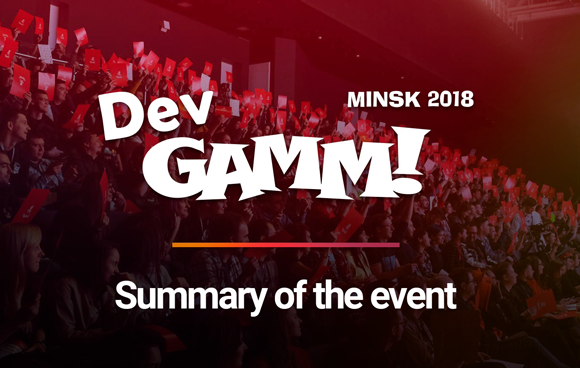
As befits a game conference, everything was beautifully decorated and there was some movement everywhere. On the one hand, girls-cosplayers who advertise characters from video games with whom they can take pictures, on the other hand, play activities in the form of VR, desktop, mobile and other applications. It was also not without quests with cool prizes, round tables, interesting reports, networking, entertainment after the first day and the Best Indie Game award of $ 30,000.
Here, only Andrei was present from us with the report “Patterns of 64-bit errors in games”, which showed what problems could be brought to bear with inaccurate use of the C ++ language.
Unfortunately, the conference audience, as at the White Nights Conference, is very blurred. At least, this impression was made by Andrey. As a result, it was programmers, and especially C ++ programmers, that there were very few that resulted in a small number of listeners who came to the report. If we want to speak there, then we need to submit more general topics.
The only exhibition on information security, which we visited this year. Information Security lasted 3 days and should have gathered 5,000 people, but it seemed to us that in fact there were 3 times fewer participants. Most of them were students who were brought by teachers from the faculties of Information Security. We had a couple of interesting conversations with teachers about the introduction of PVS-Studio into the educational program, so that future developers would already know about the methodology of static code analysis at the beginning of their professional path and use it in projects.
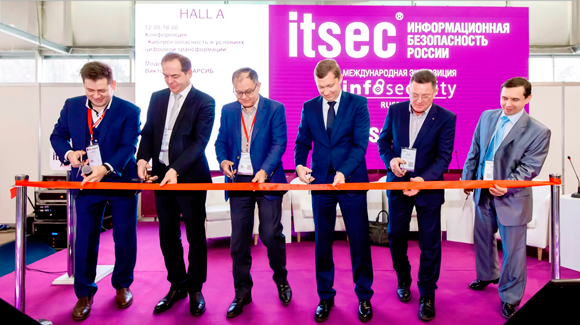
There were also a lot of elderly people who teach in educational institutions or work in the state. structures. It was funny to hear from some people whether we have disks with the program or how we are still alive if we don’t support the new GOST, because it’s not far off, and we still have only static analysis, instead of dynamic, and PHP and Python missing…
Another interesting thing that did not leave us indifferent. Since it was an exhibition, not a conference, there was no expectation of free food either. Various options were offered for snacking in the form of light salads, sausages in dough, and pies. We were not really upset and just ordered food delivery from the cafe. The exhibition lasted until 19 o'clock, and in the evening the famine had already prevailed over some stand assistants, and what was our surprise when a colleague brought a purchased sausage in the dough wrapped in packaging from women's nylon tights. Sausage in pantyhose - because we deserve it. :) That, of course, was just epic. Apparently, all the paper has already ended, and I had to use improvised means.
In general, for us, the ITSec exhibition was rather sluggish, because we did not notice the usual animation that is usually present at conferences, and the audience is not exactly our format. There were very few familiar developers and testers, as well as productive communication, the time dragged on slowly, and at the end of the day we felt very tired.
This conference intersected with the exhibition ITSec, so half of our stand assistants smoothly flowed from one place to another. It so happened that we were a bit late for SQA Days, and when we set up our stand, we noticed that almost half of the participants at this conference were girls. It’s not that I single out the gender component now, but female persons are more likely to notice some nice things. As soon as we got our statuses and the rest of the razdatku, many came up with smiles and the words “what kind of funny unicorns” and took everything that we had just laid out on the table.
The quality is not very, but, I think, the meaning of the photo is clear
Therefore, try never to be late for the conference, because if there are few stands, the crowd of participants waiting for the start of the reports will simply surround you from all sides and normally pay attention to those who did not succeed, and all that you will get as handouts will be seconds
SQA Days left a positive impression and, although testers are not our direct target audience, we think that it is also useful for them to learn more about static analysis and PVS-Studio. After the presentations of Evgeny Ryzhkov and developer Maxim Stefanov, interested participants came up to our booth, where we promised to send the key to the free PVS-Studio license. And that means all this is not in vain.
>
Heisenbug is a large technical conference that gathers over 500 testing experts under one roof. These are testers, programmers who develop tests for their code, specialists in automatic and load testing, and team managers who are thinking of increasing the effectiveness of testing in their projects. This and many other conferences are organized by the JUG.ru Group - a team of organizers of conferences and meetings for developers in various fields. Here, Andrei made a presentation on “What can static analyzers do, which programmers and testers cannot”.
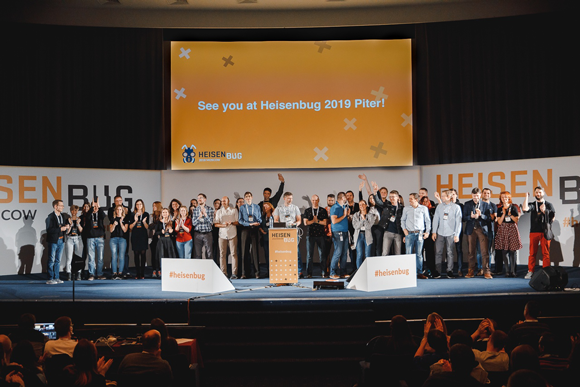
According to Andrew’s stories, he liked it very much: the atmosphere, the organization, and the reports were all held at the highest level. Therefore, next year we will take part in other conferences from JUG.ru not only with a report, but also with a stand.
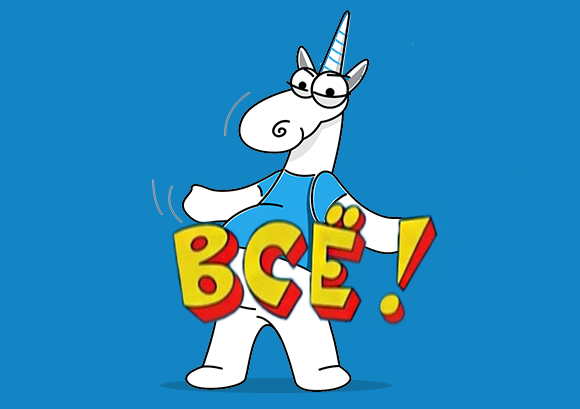
Whew, like all. In the end, I would like to add that for us it was a very active year, for which we definitely grew and gained experience in participating in conferences. Of course, something did not go very smoothly, both in the work at the stand and in the presentation of reports, but we learn from mistakes, listen to advice, conduct retrospectives, and each time our participation in various events is more successful, at least we think so :)
Does it make sense to participate in conferences? Definitely - yes, but it is not entirely clear how to measure the effectiveness of such participation. For us, this is useful, at least for the following reasons:
So it’s too early to relax, and next year we have to be more selective in choosing conferences, where we will convey our mission about static code analysis. And Andrei has a new conference calendar for 2019 already hanging on the wall.
While it is almost empty, but something tells me that it will become even more variegated than the 2018 version.
Waiting for a long time foreign lands of us.
There PVS-Studio is he a unicorn,
And the fellow developers,
Answer the question, go to us!
No, we have not smoked, this is just an introduction to this article, where we will tell about our first experience of such a close participation in the 2018 conferences.

I had such a face when my colleague Andrei Karpov showed me the list of conferences for this year and asked where I would like to go.
From April to mid-December, we regularly attended IT conferences in various cities and countries. In total, this year there were about 23 of them, which is a record for us so far. On some of them we gave presentations, mitaps and master classes, others stood with a stand or were present as listeners, and on the third we did all of the above. Of course, we have taken part in events of various levels before, but not as actively as now. Basically, a couple of times a year, our developers came with reports, but didn’t stand with a stand and didn’t attract people.
')
For clarity and more convenient management of our upcoming trips, Andrew asked to make a half-wall calendar, where he could mark the name of the conferences and the dates of their holding. As you can see from the calendar, nothing is clear, but a lot of things are highlighted, which means that a lot of work was waiting for us.

Before listing the conferences themselves, I want to give some advice to those who are just starting to participate in them and tell you in the course of how this is done with us. I will say right away that the tips are more related to grocery companies, which, in part, solve the problems of sales and marketing, rather than those who attend conferences for the sake of hunting. If you are already an experienced stand attendant or a developer who is interested only in reports and is too lazy to read the tips, in your opinion, cap, you can safely move on to the “Conferences in which we participated” section.
The appearance of the stand
Obviously, the stand and what is on it should have some kind of distinctive feature and catch the attention of the participants at a glance so that there is interest to come and talk. But one thing is to say it, and the other is to put it into practice. In fact, the stand is your business card, only on a larger scale. The more creative and informative the business card, compared to the others from the same field, the greater the chance that it will be used.
The company name, logo and main activity should be easy to read and not be too small so that people do not have to break their eyes and peer into the text. And, please, do not write vague words, a la: “We keep up with the times” and “We are cool”, even if this is your company's slogan. No one reads these phrases and for many they are just a faded spot that is ubiquitous in the vast flow of information.
Write keywords that are relevant to the conference theme and will be able to catch the audience you need. For example, at a conference for DevOps developers, you can write the name of well-known platforms where your product can be integrated, on TeamLead - something that will help control the quality of the development process and save the company's budget. For programmer conferences, insert a code that 90% of programmers will notice.
If you have well-known large customers and their logo can be used in advertising, then feel free to add it to the stand, thus, it will attract the attention of the participant. Even if he sees and hears about you for the first time, the probability of being hooked on the familiar icon is greater, which means that an interest and trust relationship may arise.
Important points of the text should not be placed too low - usually not less than 1.5 meters from the floor, so the stand attendant will not close it completely, and everything you have in mind can be noticed by the participants.
You probably think that at first I wrote that the text should be a little bit, but if everything is folded up, then you will get a sheet of letters and pictures. So, under the stand, I understand several components, namely: the back of the Pop Up or Press Wall, stand or table, Roll Up and TV for displaying information or conducting an interactive. How to place everything on these components is up to you.

On the image from left to right: white Roll Up, blue Pop Up and stand, where it folds, and the TV (thanks, cap)
We initially did not plan grandiose developments and fashionable modern stands, which are mainly at exhibitions. Because:
- Some conferences are held on one day and there is no point in building
- At most conferences where we participated, there are not many sponsors: from two to six, therefore, in any case, they will see you and fit
- There is not a very large space under the stand, where a table, a pair of chairs, Roll Up, a TV set and a back section for Press Wall or Pop Up can fit.
- Expensive

An example of our booth. From left to right: Roll Up, Andrey, Sergey, Ekaterina, Anastasia, Philip, Sergey
And we didn’t lose it, because the stand is an important, but not the main part of the work at the conference.
As we were convinced that no matter how cool and beautiful the stand was, if the people working on it, the handout or the interactive part is lame, then it is immediately useless time and money spent on sponsorship.
Handouts and activities
It is up to you to give a talk or just be present with a stand, but we think that the most optimal thing is to do both. There are different types of participants: some come only to listen to the reports, and others, on the contrary, to see who is among the sponsors, and to communicate. Therefore, in order to cover all, it is necessary to choose different types of interaction.
Usually the organizers make a brochure where all the reports and the time of their holding are collected. But in a large number of streams and information, people will just skip your talk and go to someone else. Therefore, it would not be superfluous to make flyers, leave them a little on the tables in the dining area, if possible, or attach information boards, and, of course, distribute to everyone who came to your stand.
Regarding the handout - here the flight of fancy is not limited, but we follow the rule that for a mass audience you need to take something more or less compact and light, and also not very expensive to produce.
For example, must-have at any conference are stickers. 99% of participants love and collect them. For the rest, handouts should be tested, finalized, based on the type of conference and audience, and brought back.
So, among the trinkets, magnets, stickers and other things, the most important weapon in the fight for the attention of the participants, we have the status on the desktop for programmers. They are lightweight, compact and reflect all the joy and pain of developers. Then we prepared two more types of such statuses for timlids and for testers.

For rewarding for performing more complex tasks or for the competition, we already choose prizes more expensive and weightier. It is clear that at every conference there are participants who come for a freebie, and they don’t care what to take, the main thing is that it’s free. They are not interested in what you will tell and explain there. “Just give the loot and roll away from me,” - this is his thought at the moment, and why he took it, he will figure it out later. With such, alas, nothing can be done. If recognized immediately, give something that is currently most, and the rest just for the activity.
Activities are a very important part of the job. Without them, you will be able to gather participants only at the beginning of the day, when reports have not yet begun, and many go to the stands just to take some time and see what they give out at the stands. If you are not a very well-known company, and from the handout you only have brochures about who you are and what you do, then people are unlikely to linger for a long time near your booth. In addition, at conferences, no one likes to read information about the company, where "there are many letters." You should always think of some ways to interact with the participants. For example, come up with several tasks that could be interesting to your target audience. It can be like puzzles on the sheet, in the social. networks or online, and playing on a laptop connected to a TV. For completing assignments or passing the game - give prizes, and the harder it was, the better the prize should be. The spirit of competition has not been canceled. In addition, you can then start a conversation and explain what the decision was, or how this task relates to your company.
For example, at the conference in 2018, we carried leaflets with code from various well-known projects that we already tested using the PVS-Studio analyzer. The participant was required to find an uncomplicated but interesting error in this code, and tell its essence. Whether they succeeded or not - for us this is not really important, because, in any case, this aroused interest, and the developers, alone or with colleagues, read the code and tried to identify it. After that, they approached us and showed their decision, and we did not just explain whether it was right or not, but also showed in lines how our analyzer was able to identify it. In the end, for trying, regardless of whether it was successful or not, we gave statuses to the desktop. In this way:
- The participant did not spend a lot of time breaking the brain in solving complex problems that other stands offer. After all, we remember that he still listen to the reports.
- He remembered the well-known project, as well as PVS-Studio, which found a mistake in it, which means that no matter how cool the project is and whatever minds work with it - it is not perfect. Consequently, the project that he and his team are working on may also contain errors that have not yet been discovered.
- He was awarded for his work and received a bonus in the form of a souvenir for completing the assignment.
- We talked to him at the stand and showed interest in his work. And we all love when they ask about your favorite thing.
- The fat point at the end is another bonus - a free PVS-Studio license for a month to check your project for errors.
During these 5 steps, the stand attendant positively disposes the participant to himself and to the product, which is thus preparing the ground for further work with him.
Stand attendants
We have seen many times how large, widely popular and not very well-known companies are present at conferences with a booth, but they are not taking those people to work on it. The person simply sits in the phone / laptop and is busy with his business, showing with his whole appearance that he is not interested in being here. Or is it an introvert developer who can answer narrow technical questions, but is unable to attract participants and bring them to the conversation.
The man on the stand must be fresh and tidy. In order not to get lost in the motley crowd of participants, make T-shirts or sweatshirts with a logo in your color scheme for each member of your team. Work will have to be active, but the main thing is not to overdo it. Worse indifference can only be the imposition of communication to all participants, which can further alienate. So, ideally, everything happens like this:
The girls, smiling sweetly and greeting each other, attract those who have somehow paid attention to the stand and are already about to go. They bring interested people to the primary conversation about static analysis and PVS-Studio, offer handouts for completing tasks or just like that. Usually, then it becomes interesting for a person to learn some technical details about how the program works, and then our guys are programmers. Of course, we also have developers - hoo, and they can cope with everything themselves without the support of the girls, but this is how we got, and a couple of teams were formed that showed good performance. And the majority of programmers, so most of the time, that at work, that at conferences, they see other similar programmers, so diluting with the female sex, who is interested in their work, would not be superfluous. The main thing is to try to take people not just for beauty, but who are in the subject line, what your company is doing, and can independently tell the general part.
Networking
If the conference lasts for several days, networking is best done at the end of the first day, when the organizers have beer parties and invite companies with board and interactive games. In an informal setting, you can easily meet new people and establish business connections, and learn valuable insights.
Also, some organizers arrange meetings for sponsors and some participants the day before the conference, where you can talk with your colleagues at the stands and learn a little more about the companies with which you will soon have to share the attention of the audience.
Networking is undoubtedly a useful thing, about which many articles have already been written in more detail. Therefore, be sure to stock up on a good mood, positive attitude, business cards, and try to enjoy what is happening.
Conferences in which we participated
In addition to the list of conference titles, with a short description of each conference, where we spoke, there will be a video and a presentation with a download link, if possible. Since the video organizers are not laid out immediately, the list will be periodically updated. I hope that in the coming months I will complete it. So, let's begin:
1. Basta! (February 19-23, Frankfurt am Main, Germany)
For over 20 years, Basta! - a leading and independent conference on Microsoft technologies and JavaScript. Basta! enables developers associated with C #, .NET-Framework and web technologies to keep abreast of the latest developments.
Basta! Conference for the PVS-Studio team. - This is the first conference outside of Russia and Belarus, which we attended. General Director Yevgeny Ryzhkov represented us, and this was the first “appearance” in the role of participant, speaker and sponsor.
View of the city of Frankfurt am Main
Here is how Eugene commented on this event:
Of course, only positive impressions remained from the city of Frankfurt am Main, but even more impressions were from the event itself. For the first time, I ended up at a conference of programmers, where to the question: “What do you know about PVS-Studio?” People answered: “PVS-Studio? And what is it? And it is beautiful! For us, this is a new audience, a new market, new people who still do not know about our product. Although, frankly, this is surprising, since, perhaps, Germany is in second place after the United States in the number of PVS-Studio sales in the world. This estimate is not accurate data, but I think I was not very wrong.
Marriott Hotel, where the conference was held
We sponsored the conference, and we also made a report. More precisely, we asked one of our German clients, EPLAN Software, to make a presentation on static code analysis. Roman told about it, in particular, about the experience of using PVS-Studio in their company. The report was in German, so I did not understand a word.
To be honest, I, of course, completely failed at work at a booth in the conference hall. I had neither a handout, nor colleagues who know how to work at conferences, as I was convinced later in Russia, nor any knowledge of the language. But since Basta! - this is a new audience, I am sure that we will come back here. And we will be prepared as it should!
2. CoreHard (April 7-8 and November 2-3, Minsk, Belarus)
CoreHard is a conference for C ++ developers, uniting not only C ++, but also those who are interested in C, assembler, industrial controllers and high-loaded server solutions.

This conference is the full opening of our season 2018. For three years, we come to Minsk every year as sponsors and we can say that each time the conference raises the bar and goes to a higher level, both in organization and quality of reports.
For the first time we came to it with a whole delegation of eight people with a booth and a report “How Data Flow Analysis Works in a Static Code Analyzer,” which was beautifully presented by Pavel Belikov.
Here we tested our statuses with a unicorn for programmers and the rest of the razdatku, which successfully entered the participants, understood how it is necessary and not necessary to lure programmers how to communicate with interested people so that they become even more interested and bring introverts to the conversation.
Andrei additionally visited Wargaming office on a friendly visit, where he talked with the team using PVS-Studio. He answered various questions, promised to make some improvements in the analyzer and so on. And, of course, I was photographed at the tank in their office, as without it.
Andrew and the tank
In order not to write a text wrapper, since there are 21 more O_O conferences waiting for us, you can familiarize yourself with the results of a visit to CoreHard from our post in VK .
In the fall, we again visited CoreHard with a new report from Evgeny Ryzhkov “Information Security and Software Development”. The report went well, but at the stand we understood one obvious thing: we need to bring a new handout to the very same conference. We hoped that maybe 70-80% of the new audience will be, and our merch will work as well as the first time. But as it turned out, most of the participants already had it at home, and they wanted to see something new.
Presentations of reports can be downloaded by contacting the official telegram channel of the conference.
3. C ++ Russia (April 19 - 21, St. Petersburg)
C ++ Russia gathers hundreds of experienced developers of the C ++ language, and this is the conference we attend every year, where we already feel at home and could not miss. C ++ was the first to be added to PVS-Studio, and according to it, we developed thousands of diagnostics and checked hundreds of projects .
Despite a certain number of familiar faces among the participants, we still try to convey the idea of the importance of using static analysis tools in projects to improve the quality of the code. The conference is continuously evolving and invites all new gurus and C ++ stars as speakers: Jon Kalb, Daveed Vandevoorde, Andrei Alexandrescu, Herb Sutter and others.
The conference venue at the Park Inn Pribaltiyskaya hotel, where we actually lived, was very convenient. Therefore, we did not have to spend time and effort on the road and transportation of handouts. It was enough to go down a few floors, and now we are on the stand. Based on the previous CoreHard conference and the counting of what was taken, we assumed that what Russia brought to C ++ should be enough for approximately 80% of the participants. And how we made a mistake ... All of the merch work was dismantled in almost half a day, although we tried not to distribute it just like that, but only for completing the tasks. Conclusion: take it with a reserve, it is better then to bring the part back or give it to the participants / stand assistants, but do not sit with a bare stand on the second day (but here, too, it is necessary to take into account the subject of the conference). Here we had as many as 2 reports: from technical director Andrei Karpov, who gathered such a full house that some listeners did not have enough space and had to stand, and lead developer Sergey Vasilyev.
4. Positive Hack Days 8: Digital Bet (May 15 - 16 Moscow)
Positive Hack Days is an international forum on practical security.
Sergei Vasiliev was present at the forum, who, as one of the experts at the round table, discussed issues of static analysis and SAST (Static Application Security Testing). Section participants spoke about the problems of safe development and bringing to the developer the idea of the importance of using static analysis.
From the forum itself, I remember the show “Confrontation” in the main hall, in which teams of intruders, defenders and security centers are fighting in a virtual city. For almost 30 hours, these teams fought for control of the city.
Layout of the playing ground
For example, hackers had to hack into urban infrastructure applications in order to disable the railway or turn off the lights. The defenders, in turn, had to either prevent or repair the damage.
In parallel, there were many reports on information security, master classes, and behind the scenes there were exhibitions of the achievements of the information security industry, paintings and art objects, performances of music groups, and entertainment games.
5. DevConf (May 18 Moscow)
DevConf is an annual professional conference dedicated to leading programming and web development technologies.

Despite the fact that the main part of the audience was close to the field of programming, there were not many points of contact for us in communication with the participants, as most of them carry out Backend and Mobile development in PHP, Python, JS, Go and others. Probably next time we should come here after a while, when we will support these languages.
Andrei made a presentation “Static code analysis”, where he spoke about his methodology and tools with which the analysis is performed. Videos will be available on the official YouTube channel .
6. RHS ++ (May 28 - 29, Moscow)
Oleg Bunin's conferences are among the best in Russia in terms of scale, organization, conduct, types and topics of reports. We were convinced of this by visiting RIT ++ for the first time. Unlike other organizers who offer only a certain place in the exhibition hall, and then everything depends on you, how you arrange it, here you will be asked to send mock-ups for the stand and brochures that will greatly simplify your life.
Firstly, if you have a limited budget and you cannot afford to build your own, then you will have a beautiful stand with a cabinet and a TV, which the organizers take upon themselves, and all you have to do is think out the design.
Secondly, it is not necessary to bring with you Pop Up or Press Wall, which, compared to what the organizers offer, will look cheaper and unpresentable.
Thirdly, the majority of such stands go in blocks, do not hurt the eyes and delight perfectionists.
Fourth, brochures additionally help to attract people to your product or stand, depending on how creatively you make them.
From left to right: Sergey, Vasilisa, Andrei, Philip, Sergey and Catherine
RIT ++ gathered people who are interested in system administration and operation, high-loaded systems and databases, server programming, project management and entrepreneurship, as well as front-end development. We found our audience here, were very pleased with the conference and wrote in more detail about it in the article of our VK group. We also suggest that you familiarize yourself with the presentation of the report by Sergey Vasiliev “Static analysis as an answer to the question of improving the quality of the code”
7. DevOps Days (June 16 Moscow)
DevOpsDays Moscow conference is devoted to the discussion of current techniques and technologies in the field of software development and maintenance processes.

The conference itself is cool, but from the point of view of our communication with visitors at the stand, there were mixed feelings. On the one hand, many participants were “by” and we did not find a point of contact with them. Although, on the other hand, there were visitors who knew about our product and specially approached with various questions about its work and use. We had a long and detailed discussion with some of them. It can be concluded that if the strength and resources remain, the next time it is worth taking part in this conference again.
In addition to the stand here, our developers Phillip and Svyatoslav showed a SonarQube master class for the first time, with which, changing it depending on the conference, they spent the remaining six months. It would seem, and here SonarQube, because we are developing a static analyzer PVS-Studio. But not so simple. SonarQube is a platform for ensuring continuous quality control of the code, which is able to visualize reports by several metrics at once. Such a metric can be analysis results from tools for finding errors and vulnerabilities, such as, for example, PVS-Studio or another static analyzer. So, companies that use several code quality control programs can simplify their lives using SonarQube.
You can watch a video of a similar master class further in the list in the conference Yappi Days.
8. White Nights Conference (June 28 - 29, St. Petersburg)
White Nights Conference is an international business conference dedicated to the development and promotion of games on all platforms (mobile, PC, consoles, web).
Here we stood only with a stand, and here we had a big advantage in the handouts that we took with us. For some reason, people sluggishly disassembled him, and at the end of the second day, in order not to take most of him home, I had to walk around the rest of the stands and give it to other conference participants. Probably, the main part in this was played by the fact that a mixed audience was present at the conference, which included not only programmers, but also designers, marketers, producers and other people who are not only writing code, but developing games in the general sense of the word.
The main difference between gaming conferences and focused directly on developers is the presence of a large number of beautiful and creative stands. Around everything is full of and sparkles from the monitors with prototypes of games, robots, cosplayers and other movement. There were companies side by side - monsters of the Russian gaming industry, and small indie developers. I think the participants were delighted with this event, but for us as sponsors - this is a little past.
9. ISDEF (September 21 - 22, Moscow) + ISDEF Spring 2018 (April 20 - 22, Rostov-on-Don)
IT business conference, which will be useful both for the owner, founders and top of IT companies, and for those who are just going to create a product or open a business in this area.
At ISDEF, many reports were presented on how to organize a business, participate in exhibitions, present a product, bring it to foreign markets, etc. A friendly atmosphere was present here, and networking was held in the evening, which is no less important than standing with a stand or making a presentation.

Of the small minuses in the organization, we would like to note that the time for a report was not always clearly controlled. Because of this, the speeches were increasingly shifted forward and, accordingly, the later the report, the less time left for the next speaker.
In the spring, our company was represented by Evgeny Ryzhkov with the report “10 years on the Developer Tools market: how we changed the product, marketing, and the whole business”, and in the autumn both creators of PVS-Studio, Evgeny Ryzhkov and Andrei Karpov, visited it and told about their experience in conferences with a booth. Unfortunately, the conference organizers do not allow uploading videos and presentations, so there will be no additional links in this section.
10. TeamLead Conf (September 24 - 25, St. Petersburg)
Conference for those who want to move to a new level of control for small teams. The second conference from Ontiko (Oleg Bunin), which we attended. We were already familiar with the way everything worked out here, so some things were no longer new to us, but we understood the very key words on the stand for different types of audiences. After all, before that we were only at events where the overwhelming majority are programmers.
Also more clearly shaped their goals of attending conferences. Namely, that now we are not only standing with a stand, we offer to solve problems and tell about our product, but we collect contacts of all those who are interested in PVS-Studio and send them a full Enterprise license for a month.
At this conference, apart from us, there were only 2 sponsors, which allowed the participants not to wander from the booth to the booth, and we were more productive to discuss with them various issues relating to our product. The evening program consisted of a beer party and board games, which allowed the participants to relax after a busy day, as well as make new acquaintances.
11. CppCon (September 22 - 30 Bellevue, Washington, USA)
A global conference that gathers all C ++ cream. More than 1200 C ++ programmers come here from all over America and beyond. It is here that all the new features related to the C ++ language are presented: standards, versions of popular products, reports of top speakers and authors of books.
Autograph session by Bjorn Straustrup. These are the queues lining up to get an autograph of the great and mighty C ++ author.
Unfortunately, despite the fact that this conference is on this list, none of the members of our team attended it. This is due to the difficulties and unforeseen circumstances, from which it is impossible to be 100% insured. Therefore, we were represented by our friend Robin, who is part of the C ++ community and actively participates in his life. Robin was not there all days, specifically on September 26 and 27, answering questions and telling participants about PVS-Studio.
We hope that next year we will be able to visit CppCon as part of PVS-Studio and convey to the audience about the static analysis methodology and our tool.
12. DevOps Conf (October 1 - 2, Moscow)
Professional conference on the integration of development processes, testing and operation. And again Ontiko, and again we are here. By the way, here we visited the pre-party for sponsors for the first time before the conference.

There is no point in repeating how everything is well organized and interesting here, so I’ll just leave a link to Andrei Karpov’s report “SAST, fighting potential vulnerabilities”.
Download the presentation of the report
13. BigData (October 10 - 11, Moscow)
Conference on Big Data, Data Science & AI. The conference itself was well organized and brought together experienced speakers, but for us it turned out to be not quite thematic and one of the few that we visited this year, where very few people heard about us. At the stand, an interesting dialogue with the participants happened, but not as much as we would like. Apparently, we are not quite suitable for this conference, and it is for us.

It’s good that we had a premonition that the audience was not entirely ours, and we were able to accurately guess the amount of handouts, taking only a couple of boxes with us. And yes, without Pop Up the wall, the stand looked very simple.

Andrei and Philip, judging by their faces, are very happy that they are being photographed
14. SECR (October 12 - 13, Moscow)
SECR is one of the most important IT events in Russia with a long history and recognized authority. Conference for programmers, testers and analysts, project and product managers, key decision-makers of the company, the best students and researchers.
Here, our C # developer Sergey Khrenov made his debut as a speaker, where he gave a presentation on “Static code analysis: from typos to vulnerabilities”. The audience warmly received the report and asked interesting questions. In addition, we also tried out the Master Class “The Practice of Using Static Code Analyzers”, which took second place in the rating at this conference. Svyatoslav and Philip talked about various tools in which you can conveniently visualize the results of the analysis and receive reports on many metrics.
The participant who won our hat with earflaps fit so well into the rainbow theme of the unicorn.
We liked how this conference was held. In addition to the performances, we gathered quite a lot of contacts of those who are interested in PVS-Studio, held a prize draw for the first time and are thinking of returning here next year.
https://vimeo.com/298790374
15. Joker (October 19 - 20, St. Petersburg)
The largest Java conference in Russia, which is growing every year, is becoming more interesting, hardcore and gathers more than 1,000 participants annually.

As a listener, one of our Java developers visited it and was delighted with its conduct, organization, speakers and types of reports. Especially pleased with the audience were Java puzzlers — code snippets, which sometimes work not quite as it seems at first glance. Puzzle players take place in an interactive format (speakers show a section of code and response options of what happens during its execution - the task of the audience to vote) and are an excellent way out if you want to take a break from technical conference hardcore.
Next year we will definitely visit this conference with a booth, and maybe with a report. After all, now PVS-Studio supports searching for errors in the Java language, and we have something to say about this.
16. Yappi Days (November 2 - 3, Yaroslavl)
Yappi Days - a conference where topics such as: design patterns, corporate systems architecture, distributed systems are raised; cloud technologies, containers, orchestration, Continuous Delivery / Integration; popular front end and backend frameworks; performance and application monitoring.
The last time we had a report in Yaroslavl was 8 years ago. This was the ADD2010 conference. We do not know whether it can be said that ADD2010 is the progenitor of Yappi Days, but, in any case, it is nice to see the development of similar events in Yaroslavl.

Andrew on ADD2010 The
reports were held on different topics, a sort of RHS ++, only in a smaller format. Compared to previous years, there were more sponsors and stands, so the participants had a diverse choice of communication among the stands. There may have been minor flaws during the lunch organization, but we hope the organizers will fix them in the future, and the conference will be even better. For the rest, we liked Yappi Days and maybe next year we will visit it again. In addition to the booth, we had a report: “Experience in developing a static code analyzer”, as well as a master class: “SonarQube: from installation to analyzing a production code”.
It was very nice when your stand was appreciated by the participants themselves. And although we are in second place, we definitely have where to strive and grow.

Since the event lasted one day, we decided to spend some more time in Yaroslavl, take a walk around the city and explore its sights. Of course, the Volga, no doubt - the queen of the rivers, which covers dozens of regions of Russia. In this overcast time of the year, we probably could not have been impressed by all its beauty, but passing along the embankment, we felt all the power and strength of this beautiful river. Yaroslavl itself turned out to be small: for a couple of hours, we went around the whole center of the city, where many ancient churches and temples are collected.
In conclusion, I would like to tell you about the wonderful restaurant “Miles”, which put a positive bullet on our trip to Yaroslavl. There are very few places like this place in Moscow, what can we say about the other cities of Russia. The interior, the kitchen, the service, the prices, the serving and the appearance of the dishes - all this exceeded our expectations. Given that we were limited in time and hurried to the train, we were served exactly minute by minute of strictly allotted time. Of course, it may be that we arrived, when the restaurant was just opening and there wasn’t much people, but we think that even if they have a full landing, you will still be served at the highest level. Anyone who goes to Yaroslavl, we recommend to go there.
This is not an advertisement, we just really enjoyed it there, and many positive reviews about this restaurant testify to this.
Finally, a video of the report and the master class:
17. Highload ++ (November 8 - 9, Moscow)
Highload ++ is the largest professional conference for developers of high-load systems from Ontiko. This is the largest and coolest conference this year, where we were. 3000 participants walked in a tight stream both days and did not let them relax for a minute. It was good for us. We tried to devote time to everyone (although it was not easy) and to diversify our presence on the stand with various activities and competitions. More about our participation is written in the VC group .
Video reports will be publicly available only in April.
18. City IT (November 10, Tomsk)
The largest regional conference for IT-business and professionals, which is organized by local companies. Since the region is far from Moscow / Peter (fly four hours, only not to +30 to Egypt, but to -20 to Tomsk), then people want to have some kind of movement. Here they also do them. “IT City” is a very broad conference, and this is its minus for us, but in itself it is, of course, very interesting.

This year there was a section on C ++, which was organized by the company TomskSoft. Anton Tushmintsev from this company invited Yevgeny Ryzhkov to make a presentation on “Patterns of C ++ errors that manifest themselves in cross-platform development”. Of course, he knew that the history of PVS-Studio began with the product Viva64, which was developed just to find problems when migrating to 64-bit systems. In addition, PVS-Studio now runs on Windows, Linux and macOS. Therefore, we can tell you something about the development of cross-platform applications.
Further, according to Eugene:
“I was the first time in Tomsk. I flew there from +5, and flew in at -20. It is invigorating! And flew off at five in the morning, standing on the runway of the airfield at -25 degrees. Despite this, it was cool in Tomsk, Anton made an excellent tour, showed TomskSoft office, introduced the company director Ilya Bezhodarnov, with whom we discussed migration issues ... But not programs, but programmers. From Tomsk to St. Petersburg. Apparently, I'm not the only one who is not ready for such a weather. ”
Let's return to the conference. There were sections on business, marketing, development, and legal issues. The conference was interesting for us from the point of view of a visitor, but, probably, from the point of view of sponsorship for the PVS-Studio team there is not a lot of work here. Too blurred event focus.
19. Meeting C ++ (November 15 - 17 Berlin, Germany)
Meeting C ++ is a conference that supports the C ++ community by sharing knowledge, news, blogs and events for C ++ developers.
Keynote from 50 Nikolay Josuttis
Like C ++ Russia, Meeting C ++ gathers a highly specialized and very thematic audience for us. As a sponsor for this conference, we did not manage to get there, but we managed to go with the report. Yegor Bredikhin presented the report “How to write more reliable code?”. In it, he looked at many defects in C ++ code, many of which could have been avoided using additional code quality control tools and modern methods, such as: unit testing, recommendations, new C ++ standards, code review, static analysis, dynamic analysis and more.
In Germany, as in Europe as a whole, many people get to work using a bicycle. Therefore, it was very important to do handouts associated with cycling. At many stands one could see trackers, gadgets, sports bottles and LEDs branded for IT companies.
A notable difference from the Russian conferences was the use of only glass bottles with water for participants. So Europe is struggling with plastic and environmental pollution. Unfortunately, this was not very convenient to use. It was not possible to carry an unfinished bottle with a torn metal lid, so started containers were everywhere.
The conference pleased us with many interesting reports from leading C ++ developers: Andrei Alexandrescu, Lisa Lippincott, Nikolai Josuttis and others. Also among the speakers was our compatriot - Anton Polukhin from the company Yandex.
Unfortunately, the guys did not have as much time as they would like to see the city, and on the last day of the conference they went home.
Download the presentation of the report
20. DevGAMM (November 15 - 16, Minsk, Belarus)
DevGAMM is the largest conference for gaming industry professionals in Russia, Ukraine and Belarus. It has its advantages: high-quality content on game development, a low entry threshold for novice developers, and a series of activities aimed at productive pastime and effective networking.

As befits a game conference, everything was beautifully decorated and there was some movement everywhere. On the one hand, girls-cosplayers who advertise characters from video games with whom they can take pictures, on the other hand, play activities in the form of VR, desktop, mobile and other applications. It was also not without quests with cool prizes, round tables, interesting reports, networking, entertainment after the first day and the Best Indie Game award of $ 30,000.
Here, only Andrei was present from us with the report “Patterns of 64-bit errors in games”, which showed what problems could be brought to bear with inaccurate use of the C ++ language.
Unfortunately, the conference audience, as at the White Nights Conference, is very blurred. At least, this impression was made by Andrey. As a result, it was programmers, and especially C ++ programmers, that there were very few that resulted in a small number of listeners who came to the report. If we want to speak there, then we need to submit more general topics.
21. Information Security (November 21 - 23, Moscow)
The only exhibition on information security, which we visited this year. Information Security lasted 3 days and should have gathered 5,000 people, but it seemed to us that in fact there were 3 times fewer participants. Most of them were students who were brought by teachers from the faculties of Information Security. We had a couple of interesting conversations with teachers about the introduction of PVS-Studio into the educational program, so that future developers would already know about the methodology of static code analysis at the beginning of their professional path and use it in projects.

There were also a lot of elderly people who teach in educational institutions or work in the state. structures. It was funny to hear from some people whether we have disks with the program or how we are still alive if we don’t support the new GOST, because it’s not far off, and we still have only static analysis, instead of dynamic, and PHP and Python missing…
Another interesting thing that did not leave us indifferent. Since it was an exhibition, not a conference, there was no expectation of free food either. Various options were offered for snacking in the form of light salads, sausages in dough, and pies. We were not really upset and just ordered food delivery from the cafe. The exhibition lasted until 19 o'clock, and in the evening the famine had already prevailed over some stand assistants, and what was our surprise when a colleague brought a purchased sausage in the dough wrapped in packaging from women's nylon tights. Sausage in pantyhose - because we deserve it. :) That, of course, was just epic. Apparently, all the paper has already ended, and I had to use improvised means.
In general, for us, the ITSec exhibition was rather sluggish, because we did not notice the usual animation that is usually present at conferences, and the audience is not exactly our format. There were very few familiar developers and testers, as well as productive communication, the time dragged on slowly, and at the end of the day we felt very tired.
22. SQA Days (November 23 - 24, Moscow)
This conference intersected with the exhibition ITSec, so half of our stand assistants smoothly flowed from one place to another. It so happened that we were a bit late for SQA Days, and when we set up our stand, we noticed that almost half of the participants at this conference were girls. It’s not that I single out the gender component now, but female persons are more likely to notice some nice things. As soon as we got our statuses and the rest of the razdatku, many came up with smiles and the words “what kind of funny unicorns” and took everything that we had just laid out on the table.
The quality is not very, but, I think, the meaning of the photo is clear
Therefore, try never to be late for the conference, because if there are few stands, the crowd of participants waiting for the start of the reports will simply surround you from all sides and normally pay attention to those who did not succeed, and all that you will get as handouts will be seconds
SQA Days left a positive impression and, although testers are not our direct target audience, we think that it is also useful for them to learn more about static analysis and PVS-Studio. After the presentations of Evgeny Ryzhkov and developer Maxim Stefanov, interested participants came up to our booth, where we promised to send the key to the free PVS-Studio license. And that means all this is not in vain.
>
23. Heisenbug (December 6 - 7, Moscow)
Heisenbug is a large technical conference that gathers over 500 testing experts under one roof. These are testers, programmers who develop tests for their code, specialists in automatic and load testing, and team managers who are thinking of increasing the effectiveness of testing in their projects. This and many other conferences are organized by the JUG.ru Group - a team of organizers of conferences and meetings for developers in various fields. Here, Andrei made a presentation on “What can static analyzers do, which programmers and testers cannot”.

According to Andrew’s stories, he liked it very much: the atmosphere, the organization, and the reports were all held at the highest level. Therefore, next year we will take part in other conferences from JUG.ru not only with a report, but also with a stand.
Instead of conclusion

Whew, like all. In the end, I would like to add that for us it was a very active year, for which we definitely grew and gained experience in participating in conferences. Of course, something did not go very smoothly, both in the work at the stand and in the presentation of reports, but we learn from mistakes, listen to advice, conduct retrospectives, and each time our participation in various events is more successful, at least we think so :)
Does it make sense to participate in conferences? Definitely - yes, but it is not entirely clear how to measure the effectiveness of such participation. For us, this is useful, at least for the following reasons:
- Communication with current customers. A charge of positive energy from the fact that you meet people with whom you communicate for years in the mail.
- Communication with potential customers. The opportunity to show your company the face that we are "live" and "real".
- Entertainment and training for employees. Most of our colleagues take a positive view of the trips, which are additional motivation for them in their work, and in their spare time, you can listen to interesting reports.
So it’s too early to relax, and next year we have to be more selective in choosing conferences, where we will convey our mission about static code analysis. And Andrei has a new conference calendar for 2019 already hanging on the wall.
While it is almost empty, but something tells me that it will become even more variegated than the 2018 version.
Source: https://habr.com/ru/post/434312/
All Articles
